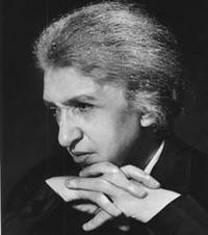1953 (Audio)
Director: Otmar Nussio
Interpretes:
- Clara HaskilArchivos para descarga:
- http://www.mediafire.com/?7dehbkscpvxbh6l

Haskil
Comentarios
Orq. RTSI
Born: January 7, 1895 – Bucharest, Romania
Died: December 7, 1960 – Brussels, Belgium
The eminent Romanian pianist, Clara Haskil began, her career as a child prodigy and entered at the Bucharest Conservatory when she was 6. At age 7 she was sent to Vienna and profited from the tutelage pf Richard Robert (whose memorable pupils included Rudolf Serkin and George Szell) and briefly with Ferruccio Busoni. She was only 7 (or 10) when she made her public debut there. At 10 she was sent to Paris to continue her training with Morpain, and, at 12, entered the Paris Conservatoire, officially to study at Alfred Cortot’s class, although most of her tuition came from Lazare Lévy and Mme Giraud-Letarse. In 1909 she took the 1st prize at the Concours de l’Union Française de la Jeunesse of Paris, and also 2nd prix at the Conservatoire. She graduated in 1910, age 15, with the Prémier Prix at the Conservatoire.
Upon graduating, Clara Haskil began to tour Europe, and also made some appearances in the USA. However she bcame best known in France and Switzerland. By the age of 18 (1913), however, she was forced to endure the first of many physical setbacks that would hold back her career, in this case a disease that kept her in a body cast for four years. She did recover, making her New York debut in 1924 and her London debut in 1926. Frequent illnesses, combined with extreme stage fright that appeared in 1920, kept her from critical or financial success. Most of her life was spent in poverty. Although it was late in her career that her name was inextricably linked with the Mozart piano concerti, at this stage she was associated with Romantic literature. Her performances of the Schumann Concerto in Philadelphia with Leopold Stokowski and Philadelphia Orchestra were widely praised.
With the outbreak of World War II, Clara Haskil was trapped in occupied Paris, but was able to escape to Marseilles. There she survived a surreptitious surgical procedure to remove a tumor from her optic nerve. In 1942 she sought refuge in Switzerland, smuggled to Vevey, where she settled for the rest of her days. In 1949 she became a naturalized Swiss citizen.
It was not until after World War II, during a series of concerts in Holland in 1949, that Clara Haskil began to win the acclaim she deserved. Thereafter enjoyed her greatest successes with a busy concert and recording schedule that took her around the world. She appeared as a soloist with the foremost orchestras and as a recitalist. Well regarded as a chamber musician, Haskil collaborated with such famed musicians as George Enescu, Eugène Ysaÿe, Pablo Casals and Arthur Grumiaux, with whom she played her last concert. Despite her amazing stamina, she proved unable to survive a fall she suffered in a Brussels (Belgium) railway station in 1960, and died one month short of her 66th birthday. She was to play a concert with Arthur Grumiaux the following day. She was buried in Paris.
A celebrated interpreter of classical and early romantic repertoire, Clara Haskil was particularly noted for her performances and recordings of W.A. Mozart. Many considered her the foremost interpreter of Mozart in her time. She was also noted as a superb interpreter of L.v. Beethoven, Schubert, Schumann, Chopin and Scarlatti. As a pianist, her playing was marked by a purity of tone and phrasing that may have come from her skill as a violinist. Transparency and sensitive inspiration were other hallmarks of her style. With Clara Haskil, musicianship came first and technical matters were irrelevant; she had enormous hands and could play a 12th in her left hand with a fingering of 2-5. She reputedly had an amazing memory, and could accurately play back a piece of music she had heard only once, even after the passage of several years, without ever having seen the score. The Clara Haskil Prize, awarded once every two years in Vevey, Switzerland, was established in 1962 as a memorial to the pianist.
